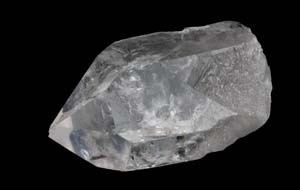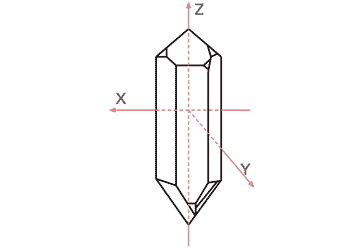What is Quartz
Quartz is used widely within the electronics industry to provide highly stable high performance resonators with exceedingly high values of Q.
Home » Electronic components » this page
Quartz Crystals, Xtals Tutorial Includes:
Quartz crystals: xtals
What is quartz
How a crystal works
Crystal overtone operation
Quartz crystal frequency pulling
Quartz crystal cuts
Quartz ageing
Crystal resonator manufacture
How to specify a quartz crystal
VCXO
TCXO
OCXO
Crystal filter
Monolithic crystal filter
Ceramic resonator & filter
Ceramic filter specifications
Quartz is a crystalline form of silicon diode, SiO2. The name Quartz is derived from the German word ‘quaz’, although others believe the word's origin is from the Saxon word Querkluftertz, meaning cross-vein ore.
Quartz is widely used within electronics where quartz resonators are used as high performance resonators for use in filters and oscillators.
Within electronic circuit designs, quartz is able to provide resonant electronic components with exceptionally high levels of Q for use within filters and oscillators.
Video: What's Inside a Quartz Crystal
Quartz basics
Quartz is a hard, crystalline mineral composed of silicon and oxygen atoms. The atoms are linked in a continuous framework of SiO4 silicon–oxygen tetrahedra, with each oxygen being shared between two tetrahedra, giving an overall chemical formula of SiO2. Quartz is the second most abundant mineral in Earth's continental crust, behind feldspar.
Quartz belongs to what is termed the trigonal crystal system. The ideal crystal shape is a six-sided prism terminating with six-sided pyramids at each end. However this is rarely seen in nature because the crystals tend to inter-grow, with other quartz crystals and even those of other minerals. This means that naturally occurring quartz often lacks the text-book crystalline shape. Typically the best shaped crystals have grown in an environment where they have been able to grown into a void, i.e. without touching other crystals of quartz or different minerals, etc.
However the crystals of quartz used for the manufacture of quartz resonators are available in very limited areas. In view of the shortages, quartz used for electronic components as high Q resonators is manufactured synthetically.
The are several interesting properties that can be attributed to quartz:
- Piezo-electric properties: Quartz exhibits the peizo-electric effect. In this if a strain is placed onto the crystal, then an electro-motive force is produced and this can be detected by placing electrodes on its surface. It is this attribute that enables the quartz crystals to be used within electronic circuit designs.
- Melting point: The melting point for quartz is above 1700°C.
- Curie temperature - alpha and beta quartz: The Curie temperature for quartz is 573°C. Below this temperature the form exits and it has its piezo-electric properties. Above 573°C most of its piezo electric properties are lost and it is referred to as beta quartz.

Of these properties, it is the piezoelectric effect combined with the very high Q mechanical resonances that make quartz virtually unique.
Although some specialised ceramics also exhibit similar properties of piezoelectricity and high Q mechanical resonances, their performance is not as good as that of quartz, although having a lower cost of manufacture, they are still widely used in many RF designs where the very high performance of quartz resonators is not needed.
Production of quartz
Quartz occurs naturally with the main sources of crystalline quartz being found in Brazil. Here crystals of many shapes and sizes were found.
With its widespread usage within the electronics industry supplies started to become exhausted by the 1940s and 1950s.
The diminishing supply lead to the development of manufacturing methods to create synthetic quartz so that quartz could be used for resonators within electronic circuit designs.
The process for manufacturing synthetic quartz entails dissolving raw silicon diode, SiO2 in an alkali water solution at around 400°C and under high pressure.
The crystals can then be grown. This is a very slow process and often growth rates are as little as 1mm per day. However this slow rate provides high purity and generally high quality crystals . The quality is as good as that found naturally.
Having control of the growth enables the crystals to be grown to meet the requirements of the crystal manufacturers. It enables different dimensions and orientations to be produced.
Quartz crystal properties
There are several key properties that quartz crystals possess which are of use:
Crystal shape: Both natural and synthetic quartz crystals have a hexagonal cross section with the ends having six sided pyramid shapes. The directions within the crystals are of major importance for resonator manufacture and they are identified as X, Y and Z axes. The Z axis runs longitudinally between the ends through the centre of the crystal, and the direction of greatest electrical sensitivity is identified as the X axis. The Y axis joins two opposite faces. As there are six faces to the crystal there are three X and Y axes.

The structure of a quartz crystal showing the different axes & faces - Left and right handed quartz: Quartz is termed enantiomorphous. This means that it has both left and right handed versions. This difference appears in the optical rotation, although other properties between the two versions are identical. Generally right handed quartz crystals are used for resonator manufacture.
- Quartz is anisotropic: Many of the properties of quartz depend upon the orientation of the quartz bar, and more importantly the lattice within the crystal. In terms of its use within quartz crystal resonators, one of the important aspects that is sensitive to its direction is the peizo electric effect. As a result the direction in which the individual quartz crystal blanks are cut determines many of their properties. Different vibration modes are excited by electrical impulses dependent upon the direction of the cut.
Forms of quartz crystal
There are many forms of quartz that exist apart from the crystals used for electronics resonators. Quartz is the second most abundant mineral in Earth's continental crust, behind feldspar.
| Quartz Type | Description |
|---|---|
| Rock crystal | Colourless & clear |
| Amethyst | Purple and transparent | Rose quartz | Pink and transparent |
| Carnelian | Reddish orange and translucent | Agate | Multicoloured and semi translucent |
| Onyx | A form of agate where the bands are straight |
| Jasper | Red to brown and opaque |
| Citrine | Yellow through reddish orange to brown and transparent |
| Prasiolite | Mint green and transparent |
Piezoelectric effect in quartz
The main reason for the use of quartz in electronic components results from the piezoelectric effect. While quartz has many other properties that appeal to many for use in jewellery, it is the electrical properties, and in particular the piezoelectric effect that mean that quartz is particularly useful in electronic circuits designs, and in particular many RF designs. As an electronic component, quartz is able to produce a remarkably high level of performance as a resonant element.
In particular, the piezoelectric effect manifests itself by the appearance of an electrical potential across the sides of a crystal it is subjected to mechanical stress.
Similarly when a potential is placed across the crystal, a slight deformation can be seen.
The reason for this is that the crystal lattice for different materials is built up in a slightly different ways. For for any crystalline substance the lattice consists of huge numbers of repetitions of the same basic atomic blocks or unit cells as they are called, arranged in an ordered fashion.
In most crystal lattices the unit cell is symmetrical, but for piezoelectric materials this is not so.
For a piezoelectric material the crystal is electrically neutral because their electrical charges are perfectly balanced: a positive charge in one place cancels out a negative charge nearby.
However, if the piezoelectric crystal is deformed, this pushes some of the atoms closer together and others may be further apart. This disturbs the balance of positive and negative charges, and causes net electrical charges to appear. This effect occurs throughout the entire structure of the crystal giving rise to net positive and negative charges on the opposite outer faces.
The piezoelectric effect actually operates in both directions - if the crystal is deformed, potentials appear on the faces, and similarly if a potential is placed across the crystal it will deform
When operating as a quartz crystal resonator, the electrical impulses from the electrical circuit are converted into mechanical vibrations which appear on the crystal itself. These vibrations are affected by the very high Q mechanical resonances of the crystal, and then the effect is reflected again back into the electrical domain.
The net effect of this is that the very high Q mechanical resonances can be used to effectively act upon the electrical signals.
Quartz is a very special material. Whilst many crystals can appear very beautiful and they are sued in forms of jewellery, the electrical aspects are also very important and enable very high Q electrical resonators to be made and used. These are unequally by any other analogue electronic component.
 Written by Ian Poole .
Written by Ian Poole .
Experienced electronics engineer and author.
More Electronic Components:
Batteries
Capacitors
Connectors
ADC
DAC
Diodes
FET
Inductors
Memory types
Phototransistor
Quartz crystals
Relays
Resistors
RF connectors
Switches
Surface mount technology
Thyristor
Transformers
Transistor
Unijunction
Valves / Tubes
Return to Components menu . . .



